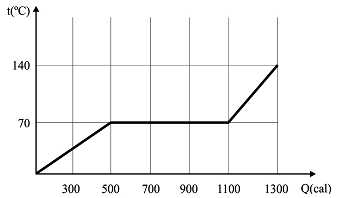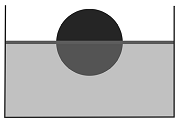Questões Militares
Para segurança pública
Foram encontradas 6.543 questões
Resolva questões gratuitamente!
Junte-se a mais de 4 milhões de concurseiros!
No que se refere às funções das estruturas celulares que constituem as células procarióticas e eucarióticas, julgue o item seguinte.
A capacidade de locomoção de uma célula procariótica deve-se
à presença de um citoesqueleto composto de filamentos
proteicos.
A respeito das propriedades químicas e físicas de determinados combustíveis, julgue o próximo item.
A gasolina é uma substância orgânica que reage com o
oxigênio do ar.
A respeito das propriedades químicas e físicas de determinados combustíveis, julgue o próximo item.
O etanol é uma substância inorgânica.
Com relação ao funcionamento desses tipos de extintores e aos seus componentes químicos, julgue o item a seguir.
A substância do extintor de pó químico é formada por ligações
covalentes e iônicas.
Com relação ao funcionamento desses tipos de extintores e aos seus componentes químicos, julgue o item a seguir.
No texto, são apresentadas fórmulas que contêm átomos de
elementos químicos de não metal e de um metal de transição.
Com relação ao funcionamento desses tipos de extintores e aos seus componentes químicos, julgue o item a seguir.
Quando em funcionamento, o extintor de espuma facilita o
contato do comburente com o combustível.
Com relação ao funcionamento desses tipos de extintores e aos seus componentes químicos, julgue o item a seguir.
A primeira substância citada no texto — NaHCO3 — pode ser
formada pela adição de CO2 a uma solução de hidróxido de
sódio.
A figura seguinte mostra o gráfico da temperatura em função da quantidade de calor absorvida por 50 gramas de uma substância, inicialmente, no estado líquido.

Com referência ao gráfico precedente, julgue o item a seguir.
Durante toda a mudança de fase a substância absorveu 600 cal
de calor.
O circuito mostrado na figura a seguir é constituído de uma fonte com força eletromotriz ε = 35 V, dos resistores R1 = 1 Ω, R2 = 2 Ω, R3 = 3 Ω e R4 = 4 Ω, e das chaves liga-desliga S1 e S2.

Considerando que todos os elementos desse circuito sejam ideais, julgue o item seguinte.
Na situação de equilíbrio, quando a chave S1 estiver aberta e a
S2 fechada, a corrente que passa por R1 é menor que 3,0 A.
O circuito mostrado na figura a seguir é constituído de uma fonte com força eletromotriz ε = 35 V, dos resistores R1 = 1 Ω, R2 = 2 Ω, R3 = 3 Ω e R4 = 4 Ω, e das chaves liga-desliga S1 e S2.

Considerando que todos os elementos desse circuito sejam ideais, julgue o item seguinte.
Na situação de equilíbrio, se as chaves S1 e S2 estiverem
fechadas, a diferença de potencial entre os pontos B e E será a
mesma que entre os pontos E e D.

A figura precedente mostra uma esfera homogênea de volume V flutuando em um líquido de densidade constante igual a ρ; metade da esfera está submersa.
Considerando que a densidade da esfera seja constante e igual a ρe, julgue o próximo item.
Na situação de equilíbrio, a densidade ρ do líquido é igual a
duas vezes a densidade ρe, isto é, ρ = 2ρe.
A figura a seguir mostra um sistema de roldanas utilizado
para resgatar um homem de 80 kg.

Considerando a figura, que as roldanas sejam ideais, os fios inextensíveis e que a gravidade local seja igual a 10 m/s2 , julgue o item a seguir.
Para suspender o homem, a força F a ser aplicada pela equipe
de resgate deverá ser igual a 450 N.
A figura a seguir mostra um sistema de roldanas utilizado
para resgatar um homem de 80 kg.

Considerando a figura, que as roldanas sejam ideais, os fios inextensíveis e que a gravidade local seja igual a 10 m/s2 , julgue o item a seguir.
Se a corda presa ao homem a ser resgatado se romper quando
ele estiver a 3,2 m do solo, ele chegará ao solo com uma
velocidade superior a 10 m/s.
Julgue o próximo item, relativo ao disposto no Estatuto dos Policiais Militares do Estado de Alagoas e nas legislações estaduais que tratam dos critérios e das condições de acesso na hierarquia militar.
O ingresso na Polícia Militar do Estado de Alagoas é privativo
a brasileiro nato, sem distinção de raça, sexo, cor ou credo
religioso, e ocorre por meio de matrícula ou nomeação depois
de aprovação em concurso público, desde que observadas as
condições determinadas no regulamento da corporação.
Julgue o próximo item, relativo ao disposto no Estatuto dos Policiais Militares do Estado de Alagoas e nas legislações estaduais que tratam dos critérios e das condições de acesso na hierarquia militar.
Situação hipotética: Durante um incêndio em determinado
edifício, um bombeiro militar constatou que duas crianças
estavam presas no prédio. Audaciosamente e com coragem,
além do cumprimento do dever legal, o bombeiro entrou no
prédio e resgatou as crianças e, em razão do ato, ele inalou
muita fumaça e sofreu graves escoriações. Assertiva: Nessa
situação, o militar poderá ser promovido por ato de bravura,
independentemente da existência de vaga.
Julgue o próximo item, relativo ao disposto no Estatuto dos Policiais Militares do Estado de Alagoas e nas legislações estaduais que tratam dos critérios e das condições de acesso na hierarquia militar.
Considera-se mais antigo, para fins de promoção, o militar que
tenha obtido, ao final do curso de formação complementar de
praça, maior grau de aproveitamento intelectual em relação aos
demais militares da sua turma.
À luz do Regulamento Disciplinar da Polícia Militar do Estado de Alagoas, julgue o item subsequente.
Denomina-se parte disciplinar o documento obrigatório que é
dirigido à autoridade competente e que contém a narração, por
escrito, de fato ou ato de natureza disciplinar praticado por
militar de posto ou de graduação inferior à do signatário.
À luz do Regulamento Disciplinar da Polícia Militar do Estado de Alagoas, julgue o item subsequente.
Configura transgressão disciplinar leve o não encaminhamento,
pelo oficial ao escalão superior, de comunicação de
subordinado a respeito de impetração de recurso sobre ato
administrativo junto ao Poder Judiciário.
À luz do Regulamento Disciplinar da Polícia Militar do Estado de Alagoas, julgue o item subsequente.
As transgressões disciplinares classificam-se, de acordo com
a sua intensidade, em leves, médias, graves ou gravíssimas.
Com base no Estatuto dos Policiais Militares do Estado de Alagoas, julgue o item a seguir.
A graduação é grau hierárquico exclusivo dos oficiais, sendo
conferido pelo chefe do Poder Executivo.